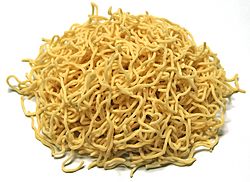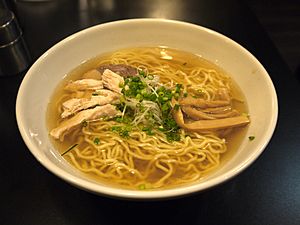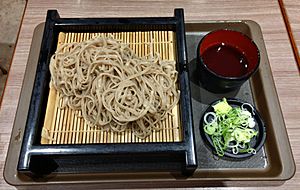Japanese noodles facts for kids

Fresh ramen
|
|
| Type | Noodles |
|---|---|
| Place of origin | Japan |
| Main ingredients | Flour, water |



Noodles are a very important part of Japanese cuisine. People often eat them chilled with special dipping sauces. They are also popular in hot soups or other warm dishes. Noodles first came to Japan from China a long, long time ago. This was during the Song Dynasty, between the Heian and early Kamakura periods.
The Story of Japanese Noodles
Noodles were first found in Japan around 800 A.D. This was during the Heian period (794–1185). The Japanese learned about this dish from China. People really liked noodles because they could be served in many different ways.
Later, during the Kamakura period (1185–1333), noodles became a common meal for most Samurai warriors. This was because noodles were healthy and not greasy. They met the Samurai's needs for good food.
During the Edo period, from 1661 to 1672, Soba noodles became very popular. Many restaurants in Edo (which is now Tokyo) served them. It is said that Soba became popular because it could be served cold. At that time, there were many fires, so the government limited how much fuel people could use for cooking.
Different Kinds of Japanese Noodles
- Ramen are thin noodles made from wheat flour, salt, water, and a special kind of alkaline water called kansui. This kansui helps the dough rise before it is rolled out. Ramen noodles came to Japan from China during the Meiji period. No one is completely sure how they arrived. But it is believed that in 1910, a Chinese restaurant in Yokohama started serving a dish called lamian. Ramen noodles are firm and usually light yellow. They can be different shapes, widths, and lengths. They are always served in a tasty broth. Some popular ramen dishes are shōyu ramen, shio ramen, miso ramen, tonkotsu ramen, and curry ramen.
- Shirataki are clear noodles made from a plant called konnyaku. These noodles have a chewy or slightly rubbery texture. Shirataki are often used to add an interesting feel to dishes like sukiyaki and oden.
- Soba is a noodle made from buckwheat and wheat flour. You can find soba noodles dried or fresh. They can be served with hot broth or cold with a dipping sauce called tsuyu. Some soba dishes include zaru soba (which is chilled), kake soba, tempura soba, kitsune soba, and tororo soba. Even though the popular Japanese dish Yakisoba has "soba" in its name, it is actually made with Chinese-style noodles.
- Sōmen noodles are very thin, white, and made from wheat. People usually eat them chilled in the summer with dipping sauces. But they can also be used in soups and other hot dishes. Sōmen noodles are very similar to hiyamugi and udon noodles. However, they are much thinner, about 1.3mm wide. Sōmen needs oil to be made. In the summer, Japanese people eat chilled sōmen to help them stay cool.
- Hiyamugi are wheat flour noodles. They are similar to sōmen and udon noodles in size. They are somewhere between the two. These noodles are often served in the same ways as sōmen and udon noodles. Most hiyamugi noodles are white. But sometimes you can find bundles mixed with pinkish or brown noodles.
- Udon are the thickest noodles in Japanese cooking. Udon are white, wheat-based noodles, about 4-6mm wide. In the summer, they are served chilled with a dipping sauce. When it's colder, they are used in hot dishes and soups. Some udon dishes are kitsune udon, Nabeyaki udon, curry udon, and yaki udon. However, sara udon uses a different kind of crispy noodle.
There are three places in Japan famous for their Udon noodles: Kagawa (Sanuki udon), Gunma (Mizusawa udon), and Akita (Inaniwa udon). These regions created unique Udon recipes. They also have interesting stories about how Udon was made and eaten there. Kagawa is known as the "kingdom of Sanuki udon." Its noodles are a symbol of the area. Gunma is also a great place to try local Udon because of its many noodle shops.
- Harusame are clear noodles, sometimes called glass noodles. They are made from potato starch. These noodles are often used in hotpot dishes and salads. They are also used to make Japanese versions of Korean and Chinese noodle dishes. A popular Harusame dish is harusame salad. This is a cold noodle salad with shredded cucumbers, ham, and carrots. Other things like wakame seaweed, shredded egg omelet, tomatoes, and bean sprouts can also be added.
- Tokoroten are jelly-like slices. They are made from Kanten, which comes from a type of seaweed called tengusa. This dish was usually eaten in the summer because it is almost all water (about 98%). The story of Tokoroten goes back to 1658. An innkeeper threw away some Tokoroten, and it dried into strips of Kanten. These strips could be stored and saved. Tokoroten is usually served with soy sauce and rice vinegar.
See also
 In Spanish: Fideos japoneses para niños
In Spanish: Fideos japoneses para niños
- Champon, a noodle soup from Japan with Chinese influences
- Chinese noodles
- Instant noodles
- Korean noodles
- List of noodle dishes
- List of noodles
- Sapporo Ichiban
- Yakisoba, a popular noodle dish

